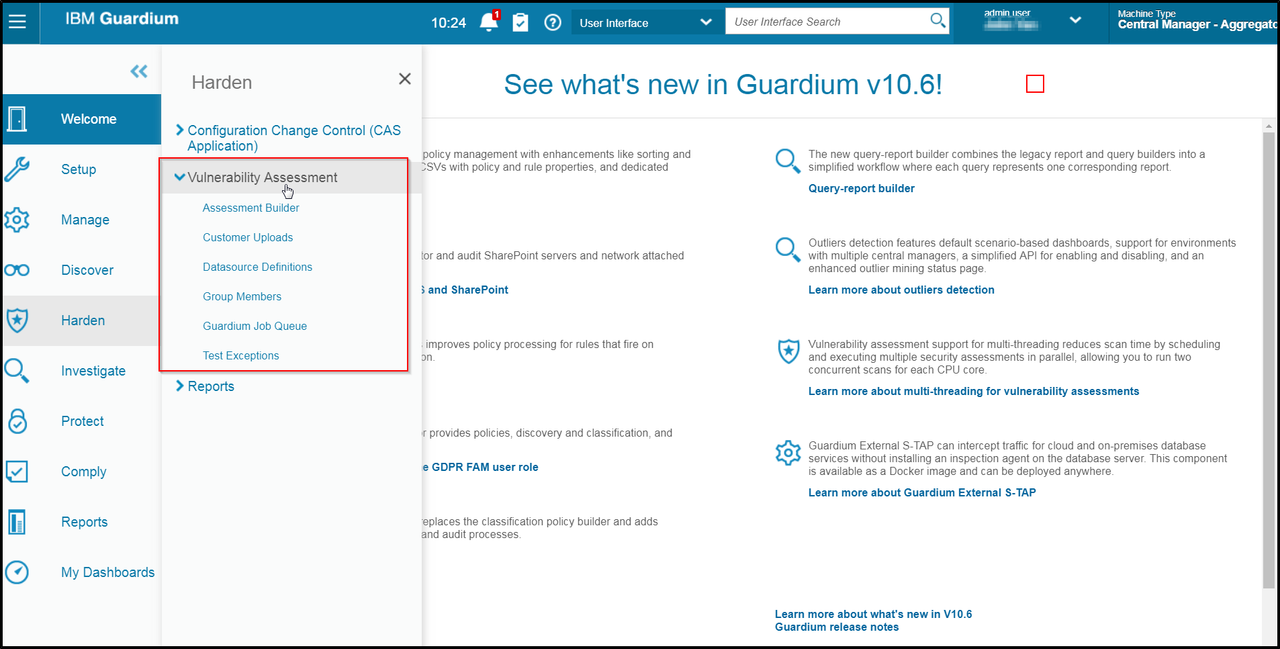 The IBM® InfoSphere® Guardium® Database Vulnerability Assessment (VA) module scans your database infrastructure for vulnerabilities and provides an ongoing evaluation of your security posture, using both real-time and historical data. This capability includes a comprehensive library of preconfigured tests based on industry-best practices such as the Computer Internet Security (CIS) benchmarks and the Database Security Technical Implementation Guide (STIG) created by the Department of Defense (DoD). These tests check for common vulnerabilities, such as missing patches, weak passwords, misconfigured privileges and default accounts, as well as unique vulnerabilities for each DBMS platform.
The IBM® InfoSphere® Guardium® Database Vulnerability Assessment (VA) module scans your database infrastructure for vulnerabilities and provides an ongoing evaluation of your security posture, using both real-time and historical data. This capability includes a comprehensive library of preconfigured tests based on industry-best practices such as the Computer Internet Security (CIS) benchmarks and the Database Security Technical Implementation Guide (STIG) created by the Department of Defense (DoD). These tests check for common vulnerabilities, such as missing patches, weak passwords, misconfigured privileges and default accounts, as well as unique vulnerabilities for each DBMS platform. This post is to record steps how to configure IBM Guardium to do Vulnerability Assessment.
Summary:
Summary:
1. Get some scripts to run on DB2 and MSSQL DB to create user and grant permission.
- Database privileges for vulnerability assessments and classification: https://www.ibm.com/support/knowledgecenter/en/SSMPHH_11.2.0/com.ibm.guardium.doc/assess/va_scripts.html
2. Create Database Sources in Guardium for VA
- Creating a datasource definition: https://www.ibm.com/support/knowledgecenter/SSMPHH_11.2.0/com.ibm.guardium.doc/discover/creatingadatasourcedefinition.html
3. Create VA task
- Creating an assessment: https://www.ibm.com/support/knowledgecenter/SSMPHH_11.2.0/com.ibm.guardium.doc/assess/t_create_assessment.html
4. Create Audit Process to distribute reports.
- How to create an Audit Workflow: https://www.ibm.com/support/knowledgecenter/SSMPHH_11.2.0/com.ibm.guardium.doc/monitor/how_to_create_an_audit_workflow.html
Preparation for Vulnerability Assessment
| 1 Download Script to Run in DB Server to Create User and Proper Permissions |
Log into IBM Guardium Central Manager's CLI with your SSH client.
Log in with user guardcli1
set your guiuser then enable file service.
login as: guardcli1 Pre-authentication banner message from server: | | IBM Guardium, Command Line Interface (CLI) | End of banner message from server [email protected]'s password: Access denied [email protected]'s password: Last failed login: Wed Jul 3 10:17:36 EDT 2019 from 10.10.136.2 on ssh:notty There was 1 failed login attempt since the last successful login. Welcome guardcli1 - this is your first login in this system. Your password has expired. Changing password for 'guardcli1'. Enter current password: Enter new password: Re-enter new password: Bad password: it is based on a dictionary word Changing password for 'guardcli1'. Enter current password: Enter new password: Re-enter new password: test-igcm1.51sec.org> set guiuser admin Enter current password: err test-igcm1.51sec.org> set guiuser jyan Enter current password: ok test-igcm1.51sec.org> test-igcm1.51sec.org> test-igcm1.51sec.org> fileserver 10.10.136.2 2600 Starting the file server... The file server is ready at https://test-igcm1.51sec.org:8445 The timeout has been set to 2600 seconds and it may timeout during the uploading. The upload will only be accessible from the IP you are logged in from: 10.10.136.2 Press ENTER to stop the file server. Warning: Stop the fileserver because of timeout. The file upload may not complete. Stopping process ok test-igcm1.51sec.org>
Open our browser to your IBM Guardium Central Manager's port 8445 web page:
Then click logs\debug-logs\gdmmonitor_scripts, you will get to a page with all gdmmonitor sql script page.
Since we are using DB2 database as a VA example, lets click gdmmonitor-db2.sql file to see what is in it.
--=================================================================================== -- ------------------------------ -- Description -- ------------------------------ -- Database Type: DB2 LUW -- -- This script grants the required privileges for VA on the database. -- -- -- This script must be executed using a DB2 user with either DBADM or SECADM authority. -- -- This script does not create a user. You can grant these privileges to any user(s) you -- choose to perform your scan. If you choose to create a new OS user for this function, the Linux syntax -- can be as simple as: -- -- groupadd gdmmon -- useradd -m -d /home/gdm_user -g gdmmon gdm_user -- passwd gdm_user -- -- ------------------------------ -- Before running this script -- ------------------------------ -- -- Make sure you have created an OS group called "gdmmon". Make sure your scan user is a member of the "gdmmon" group. -- -- ------------------------------ -- How to Run -- ------------------------------ -- -- You can run these grants in any JDBC client, just make sure the statement separator is set to 'go' -- You can also run this in the DB2 CLI using the terminator as 'go' which is the default. -- -- To run this script using the DB2 CLI, run the following: -- -- db2 connect to <database> user <db2inst1> using <password> -- db2 -tdgo -vf gdmmonitor-db2.sql -- -- ------------------------------ -- after runnign this script -- ------------------------------ -- Nothing to do -- -- ------------------------------ -- User/Password to use -- ------------------------------ -- User: <gdm_user> -- Pass: user defined -- Role: gdmmon --=================================================================================== GRANT CONNECT ON DATABASE TO GROUP gdmmon go GRANT SELECT ON TABLE SYSCAT.COLAUTH TO GROUP gdmmon go GRANT SELECT ON TABLE SYSCAT.DBAUTH TO GROUP gdmmon go GRANT SELECT ON TABLE SYSCAT.INDEXAUTH TO GROUP gdmmon go GRANT SELECT ON TABLE SYSCAT.LIBRARYAUTH TO GROUP gdmmon go GRANT SELECT ON TABLE SYSCAT.PACKAGEAUTH TO GROUP gdmmon go GRANT SELECT ON TABLE SYSCAT.PASSTHRUAUTH TO GROUP gdmmon go GRANT SELECT ON TABLE SYSCAT.ROUTINEAUTH TO GROUP gdmmon go GRANT SELECT ON TABLE SYSCAT.SCHEMAAUTH TO GROUP gdmmon go GRANT SELECT ON TABLE SYSCAT.SEQUENCEAUTH TO GROUP gdmmon go GRANT SELECT ON TABLE SYSCAT.TABAUTH TO GROUP gdmmon go GRANT SELECT ON TABLE SYSCAT.TBSPACEAUTH TO GROUP gdmmon go GRANT SELECT ON TABLE SYSCAT.TABLES TO GROUP gdmmon go GRANT SELECT ON TABLE SYSCAT.INDEXES TO GROUP gdmmon go GRANT SELECT ON TABLE SYSCAT.LIBRARIES TO GROUP gdmmon go GRANT SELECT ON TABLE SYSCAT.MODULES TO GROUP gdmmon go GRANT SELECT ON TABLE SYSCAT.PACKAGES TO GROUP gdmmon go GRANT SELECT ON TABLE SYSCAT.ROUTINES TO GROUP gdmmon go GRANT SELECT ON TABLE SYSCAT.SCHEMATA TO GROUP gdmmon go GRANT SELECT ON TABLE SYSCAT.SEQUENCES TO GROUP gdmmon go GRANT SELECT ON TABLE SYSCAT.TABLESPACES TO GROUP gdmmon go GRANT SELECT ON TABLE SYSIBM.SYSROUTINEAUTH TO GROUP gdmmon go GRANT SELECT ON TABLE SYSCAT.ROLEAUTH TO GROUP gdmmon go GRANT SELECT ON TABLE SYSCAT.ROLES TO GROUP gdmmon go GRANT SELECT ON TABLE SYSCAT.CONTEXTS TO GROUP gdmmon go GRANT SELECT ON TABLE SYSCAT.AUDITPOLICIES TO GROUP gdmmon go GRANT SELECT ON TABLE SYSCAT.AUDITUSE TO GROUP gdmmon go GRANT SELECT ON TABLE SYSCAT.TRIGGERS TO GROUP gdmmon go GRANT SELECT ON TABLE SYSCAT.MODULES TO GROUP gdmmon go GRANT SELECT ON TABLE SYSCAT.NICKNAMES TO GROUP gdmmon go GRANT SELECT ON TABLE SYSCAT.TABCONST TO GROUP gdmmon go GRANT SELECT ON TABLE SYSCAT.THRESHOLDS TO GROUP gdmmon go GRANT SELECT ON TABLE SYSIBM.SYSDUMMY1 TO GROUP gdmmon go -- JDBC Access GRANT EXECUTE ON PACKAGE NULLID.SYSSH200 TO GROUP gdmmon go -- For DB2 8.1 fixpack 9 and higher this table function is need to determine the database version -- IF YOU ARE RUNNING OLDER VERSION, YOU MAY SEE ERROR ON THESE GRANT WHICH CAN BE IGNORE GRANT EXECUTE ON FUNCTION SYSPROC.ENV_GET_INST_INFO TO GROUP gdmmon go GRANT EXECUTE ON FUNCTION SYSPROC.ENV_GET_SYS_INFO TO GROUP gdmmon go --SYSPROC.ADMIN_GET_ENCRYPTION_INFO is available in DB2 10.5 and higher. GRANT EXECUTE ON FUNCTION SYSPROC.ADMIN_GET_ENCRYPTION_INFO TO GROUP gdmmon go GRANT EXECUTE ON FUNCTION SYSPROC.ENV_GET_REG_VARIABLES TO GROUP gdmmon go --This grant For DB2 9.5 and above only. This is very important, if database is created using RESTRICTIVE option --then most privilege are revoke to PUBLIC by default. We will need this grant to select certain catalog view or else error. GRANT USAGE ON WORKLOAD SYSDEFAULTUSERWORKLOAD TO GROUP GDMMON go GRANT SELECT ON TABLE SYSIBMADM.PRIVILEGES TO GROUP GDMMON go --These are require to check configuration parameters as of DB2 9.1 and higher GRANT SELECT ON TABLE SYSIBMADM.DBCFG TO GROUP gdmmon go GRANT SELECT ON TABLE SYSIBMADM.DBMCFG TO GROUP gdmmon go --These are require for dependcies entitlement queries as of DB2 9.1 and higher GRANT SELECT ON TABLE SYSCAT.TABDEP TO GROUP gdmmon go GRANT SELECT ON TABLE SYSCAT.TRIGDEP TO GROUP gdmmon go GRANT SELECT ON TABLE SYSCAT.ROUTINEDEP TO GROUP gdmmon go GRANT SELECT ON TABLE SYSCAT.PACKAGEDEP TO GROUP gdmmon go -- -- DB2 Command line privilege need to execute queries when CAS script connected to database. -- When a DB2 database is created using the RESTRICTIVE keyword. Most objects are not granted to PUBLIC, hence we need this. -- Therefore we need these privileges to be able to connect to DB2 command line and issue select queries for VA. -- The below store procedure find package name in NULLID schema begin with SQLC2 and grant execute to gdmmon group. -- This stored procedure is tested using DB2 8.2 to latest DB2 release on various platform and has the blessing of DB2 security team. -- create procedure P_GrantPackage LANGUAGE SQL begin declare executestring varchar(100); declare v_PkgSchema varchar(50); declare v_PackageName varchar(50); declare SQLCODE int default 0; declare c_grant_package cursor for SELECT PKGSCHEMA, PKGNAME FROM SYSCAT.PACKAGES WHERE PKGNAME LIKE 'SQLC2%'; open c_grant_package; fetch_loop: loop fetch c_grant_package into v_PkgSchema, v_PackageName; if (SQLCODE <> 0) then leave fetch_loop; end if; set executestring = 'GRANT EXECUTE ON PACKAGE ' ||v_PkgSchema|| '.' || v_PackageName || ' TO GROUP GDMMON'; execute immediate executestring; end loop fetch_loop; close c_grant_package; end go CALL P_GrantPackage go drop procedure P_GrantPackage go
We will have to follow the instruction to create a gdmmon group and add a gdm_user into this group on DB2 server.
Once we have right group created, we can run the script on DB2 server.
Reference: Introducing Guardium Vulnerability Assessment
Notes:
- For both Vulnerability Assessments and Entitlements Reporting, when looking for scripts to grant privileges for entitlement reporting, use scripts in the gdmmonitor_scripts directory. Do not use the entitlement_monitor_role folder, which is no longer updated.
- When using an expiring product license key, or license with a limited number of datasources, the following message may appear: Cannot add datasource. The maximum number of datasources allowed by license has been reached. The License valid until date and Number of datasources can be seen on the System Configuration panel of the Administrator Console. A Vulnerability or Classification process with N datasources are counted as N scans every time they run.
- Guardium Vulnerability Assessments requires access to the databases it evaluates. To do this, Guardium provides a set of SQL scripts (one script for each database type) that creates users and roles in the database to be used by Guardium.
- The template scripts are available on the Guardium system once it is built and can be found and downloaded via fileserver at the following path: /log/debug-logs/gdmmonitor_scripts/. More information is available in the README.txt file.
2 Create DataSource
If there is not defined Datasource yet, you will need to create a new one based on your DB information.
Protect - Security Assessment Builder
2 Choose datasource
3 Configure Tests
Tests are updated on a quarterly basis by way of the InfoSphere Guardium Knowledgebase service. You can also define custom tests and schedule automated audit tasks incorporating scans, distribution of reports, electronic sign-offs and escalations.
You will need to tell your assessment what kind of tests will be used to assess your DB. You can choose those pre-defined tests based on your DB type.
4 Run it Once
5 View results
You will need to tell your assessment what kind of tests will be used to assess your DB. You can choose those pre-defined tests based on your DB type.
4 Run it Once
5 View results
6 Check Guardium Job Queue
Schedule Assessment
1 Comply - Audit Process Builders
3 Add User to Send Report and Create a schedule
2 Add a Task
You will need to add a task you defined in previous step in the Protect - Security Assessment Builder .
You will also need to add who you want to send results and create a schedule to run this audit process.
YouTube: Vulnerabilty Assessment:
YouTube: Vulnerabilty Assessment:
References
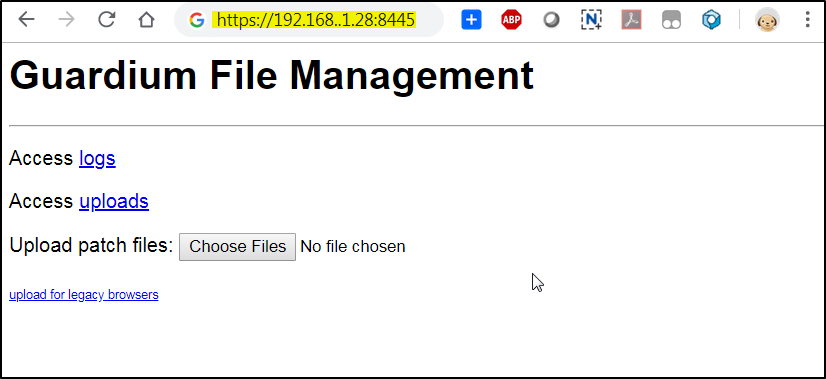
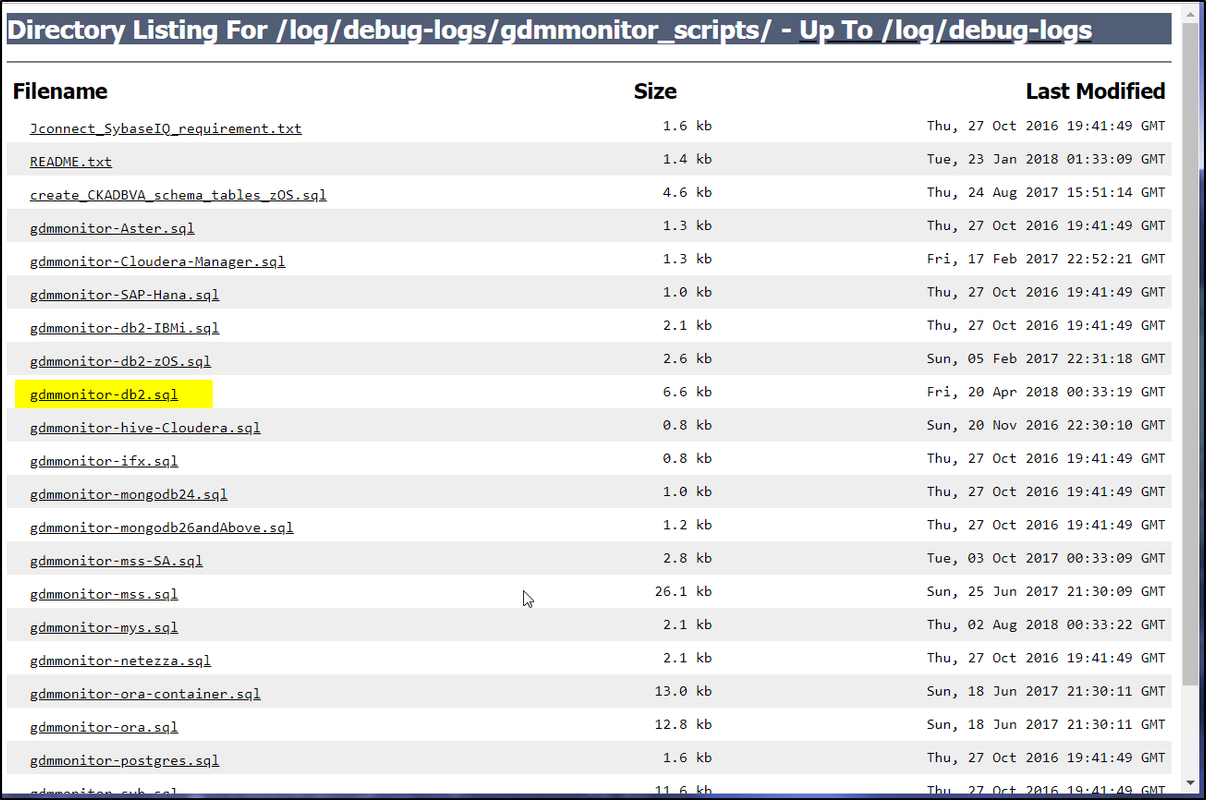
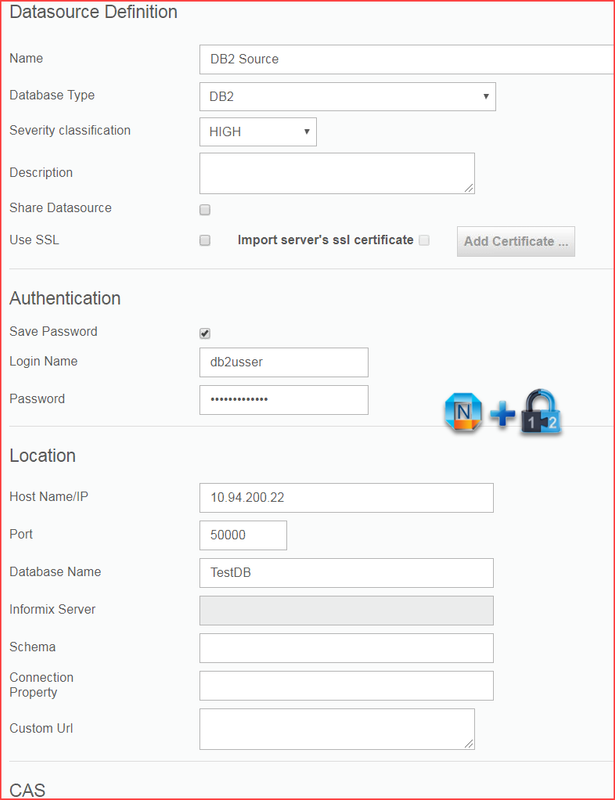

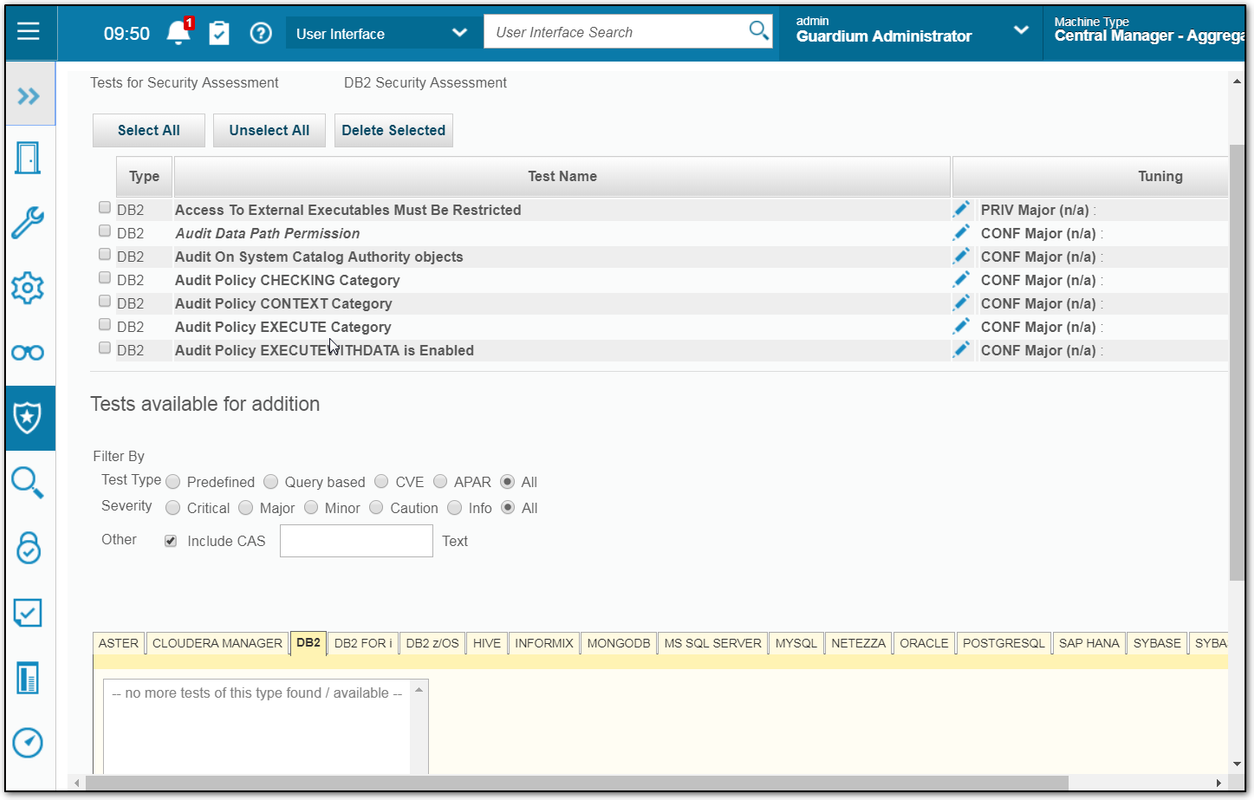
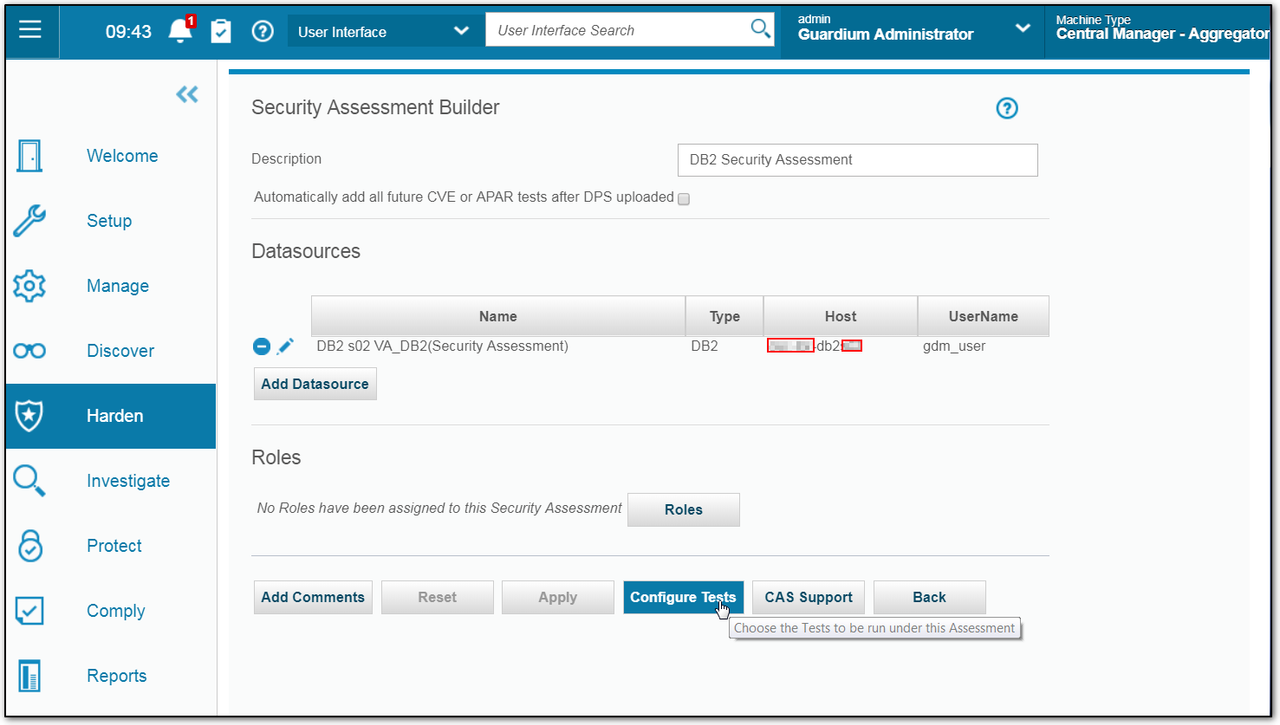
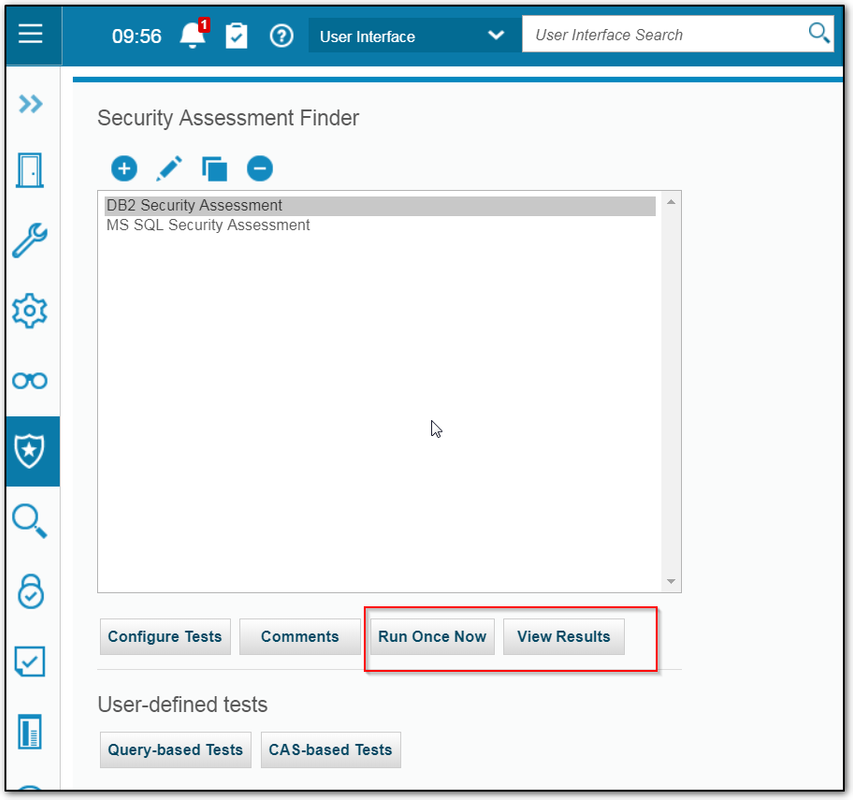
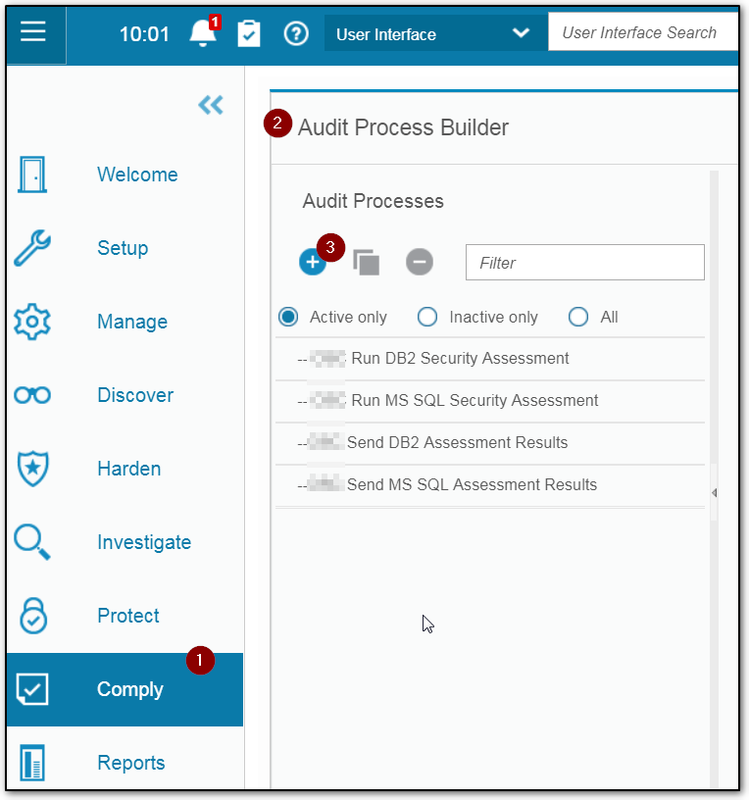

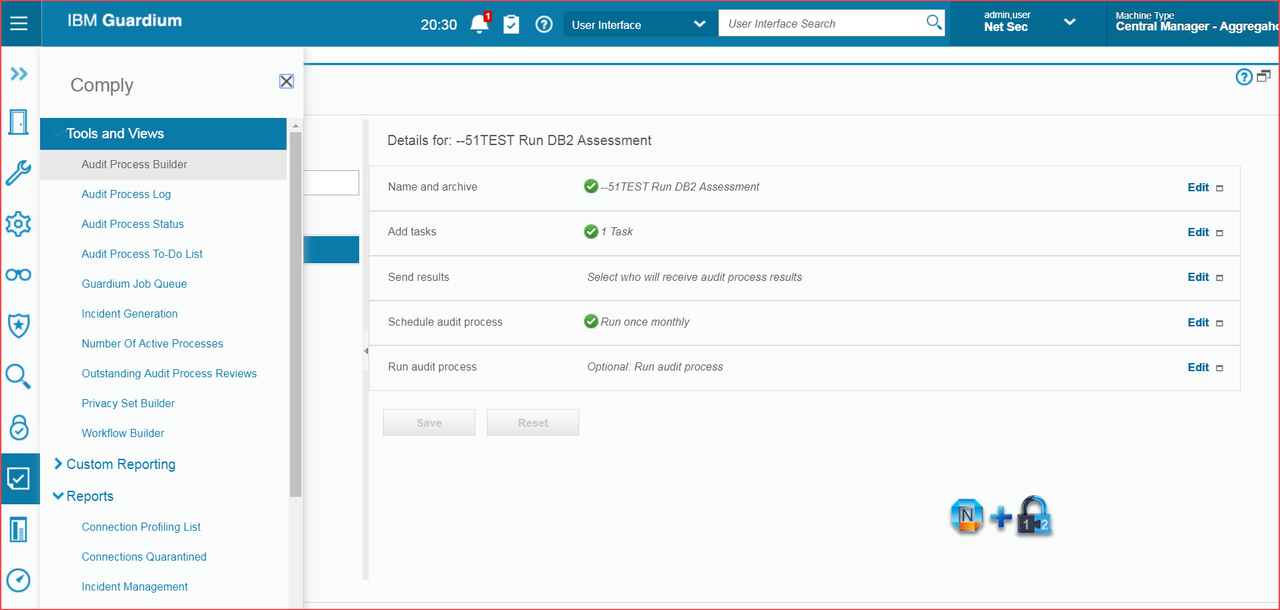
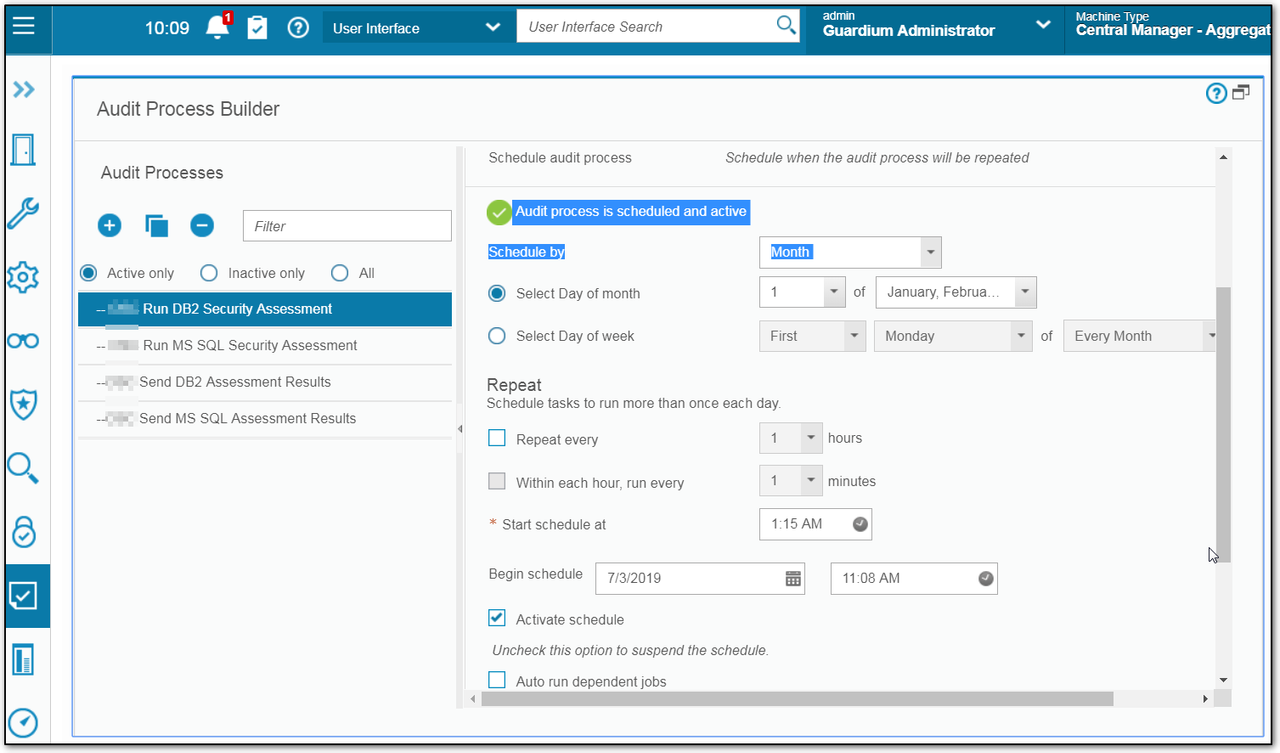
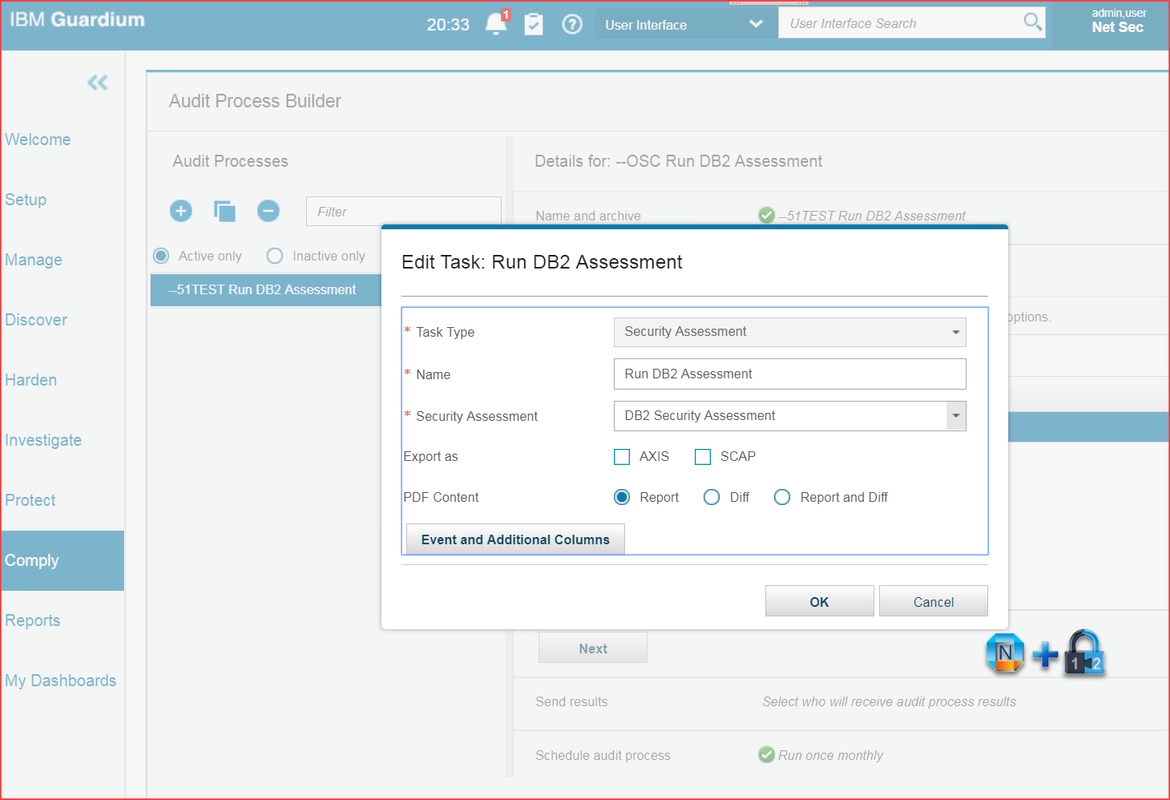







Hi, I tried to ran it, but when I pick up on "run once now" it generates the schedule on the "schedule jobs list" but it stayed a long time on "waiting" status and then dissapear without generated anything, when I go back to "Assesmment builder" and pick up on "view results" it shows an error as if we never ran the report. Do you know what could it be?
ReplyDeleteCould you check if there is any other job running in Guardium Job Queue? Is there any patching or upgrading task running in the system?
Delete